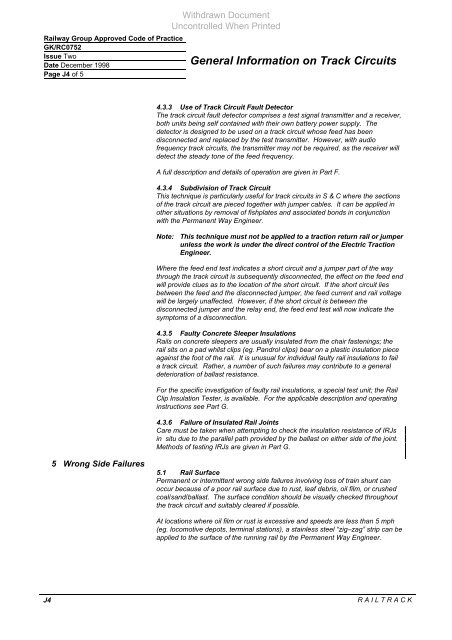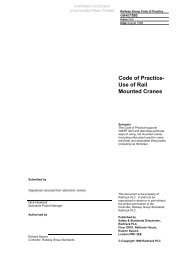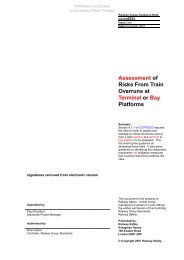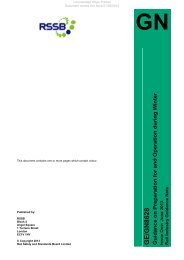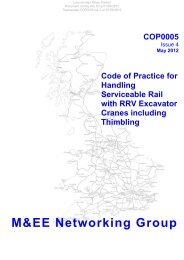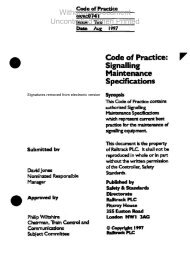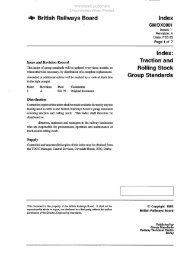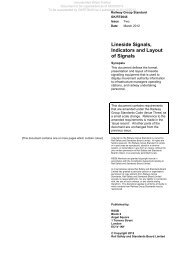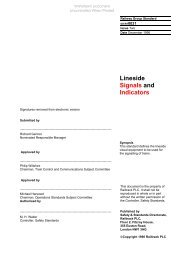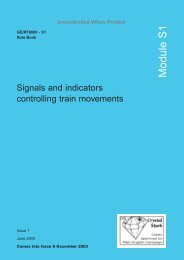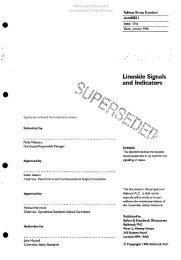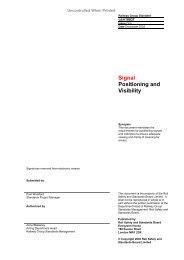General Information on Track Circuits - RGS Online
General Information on Track Circuits - RGS Online
General Information on Track Circuits - RGS Online
You also want an ePaper? Increase the reach of your titles
YUMPU automatically turns print PDFs into web optimized ePapers that Google loves.
Railway Group Approved Code of Practice<br />
GK/RC0752<br />
Issue Two<br />
Date December 1998<br />
Page J4 of 5<br />
5 Wr<strong>on</strong>g Side Failures<br />
Withdrawn Document<br />
Unc<strong>on</strong>trolled When Printed<br />
<str<strong>on</strong>g>General</str<strong>on</strong>g> <str<strong>on</strong>g>Informati<strong>on</strong></str<strong>on</strong>g> <strong>on</strong> <strong>Track</strong> <strong>Circuits</strong><br />
4.3.3 Use of <strong>Track</strong> Circuit Fault Detector<br />
The track circuit fault detector comprises a test signal transmitter and a receiver,<br />
both units being self c<strong>on</strong>tained with their own battery power supply. The<br />
detector is designed to be used <strong>on</strong> a track circuit whose feed has been<br />
disc<strong>on</strong>nected and replaced by the test transmitter. However, with audio<br />
frequency track circuits, the transmitter may not be required, as the receiver will<br />
detect the steady t<strong>on</strong>e of the feed frequency.<br />
A full descripti<strong>on</strong> and details of operati<strong>on</strong> are given in Part F.<br />
4.3.4 Subdivisi<strong>on</strong> of <strong>Track</strong> Circuit<br />
This technique is particularly useful for track circuits in S & C where the secti<strong>on</strong>s<br />
of the track circuit are pieced together with jumper cables. It can be applied in<br />
other situati<strong>on</strong>s by removal of fishplates and associated b<strong>on</strong>ds in c<strong>on</strong>juncti<strong>on</strong><br />
with the Permanent Way Engineer.<br />
Note: This technique must not be applied to a tracti<strong>on</strong> return rail or jumper<br />
unless the work is under the direct c<strong>on</strong>trol of the Electric Tracti<strong>on</strong><br />
Engineer.<br />
Where the feed end test indicates a short circuit and a jumper part of the way<br />
through the track circuit is subsequently disc<strong>on</strong>nected, the effect <strong>on</strong> the feed end<br />
will provide clues as to the locati<strong>on</strong> of the short circuit. If the short circuit lies<br />
between the feed and the disc<strong>on</strong>nected jumper, the feed current and rail voltage<br />
will be largely unaffected. However, if the short circuit is between the<br />
disc<strong>on</strong>nected jumper and the relay end, the feed end test will now indicate the<br />
symptoms of a disc<strong>on</strong>necti<strong>on</strong>.<br />
4.3.5 Faulty C<strong>on</strong>crete Sleeper Insulati<strong>on</strong>s<br />
Rails <strong>on</strong> c<strong>on</strong>crete sleepers are usually insulated from the chair fastenings; the<br />
rail sits <strong>on</strong> a pad whilst clips (eg. Pandrol clips) bear <strong>on</strong> a plastic insulati<strong>on</strong> piece<br />
against the foot of the rail. It is unusual for individual faulty rail insulati<strong>on</strong>s to fail<br />
a track circuit. Rather, a number of such failures may c<strong>on</strong>tribute to a general<br />
deteriorati<strong>on</strong> of ballast resistance.<br />
For the specific investigati<strong>on</strong> of faulty rail insulati<strong>on</strong>s, a special test unit; the Rail<br />
Clip Insulati<strong>on</strong> Tester, is available. For the applicable descripti<strong>on</strong> and operating<br />
instructi<strong>on</strong>s see Part G.<br />
4.3.6 Failure of Insulated Rail Joints<br />
Care must be taken when attempting to check the insulati<strong>on</strong> resistance of IRJs<br />
in situ due to the parallel path provided by the ballast <strong>on</strong> either side of the joint.<br />
Methods of testing IRJs are given in Part G.<br />
5.1 Rail Surface<br />
Permanent or intermittent wr<strong>on</strong>g side failures involving loss of train shunt can<br />
occur because of a poor rail surface due to rust, leaf debris, oil film, or crushed<br />
coal/sand/ballast. The surface c<strong>on</strong>diti<strong>on</strong> should be visually checked throughout<br />
the track circuit and suitably cleared if possible.<br />
At locati<strong>on</strong>s where oil film or rust is excessive and speeds are less than 5 mph<br />
(eg. locomotive depots, terminal stati<strong>on</strong>s), a stainless steel “zig–zag” strip can be<br />
applied to the surface of the running rail by the Permanent Way Engineer.<br />
J4 R A I L T R A C K


